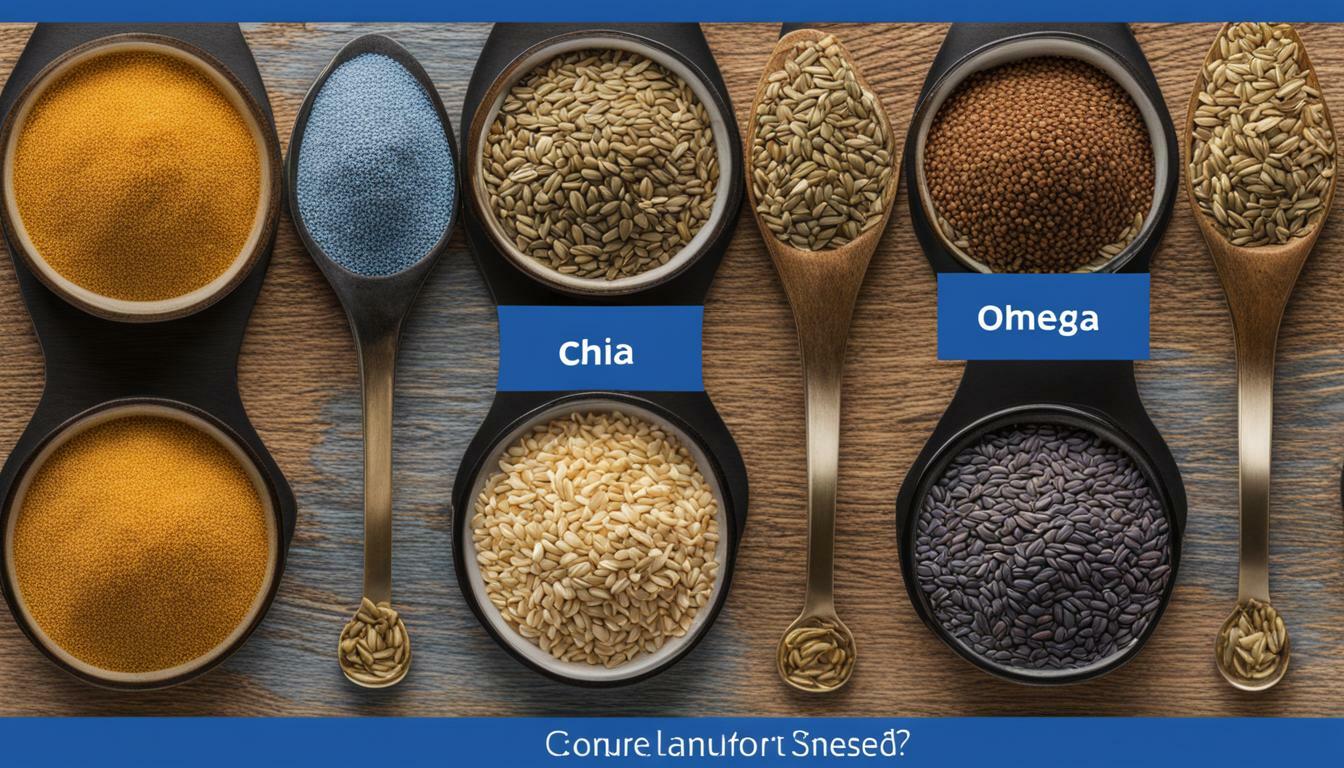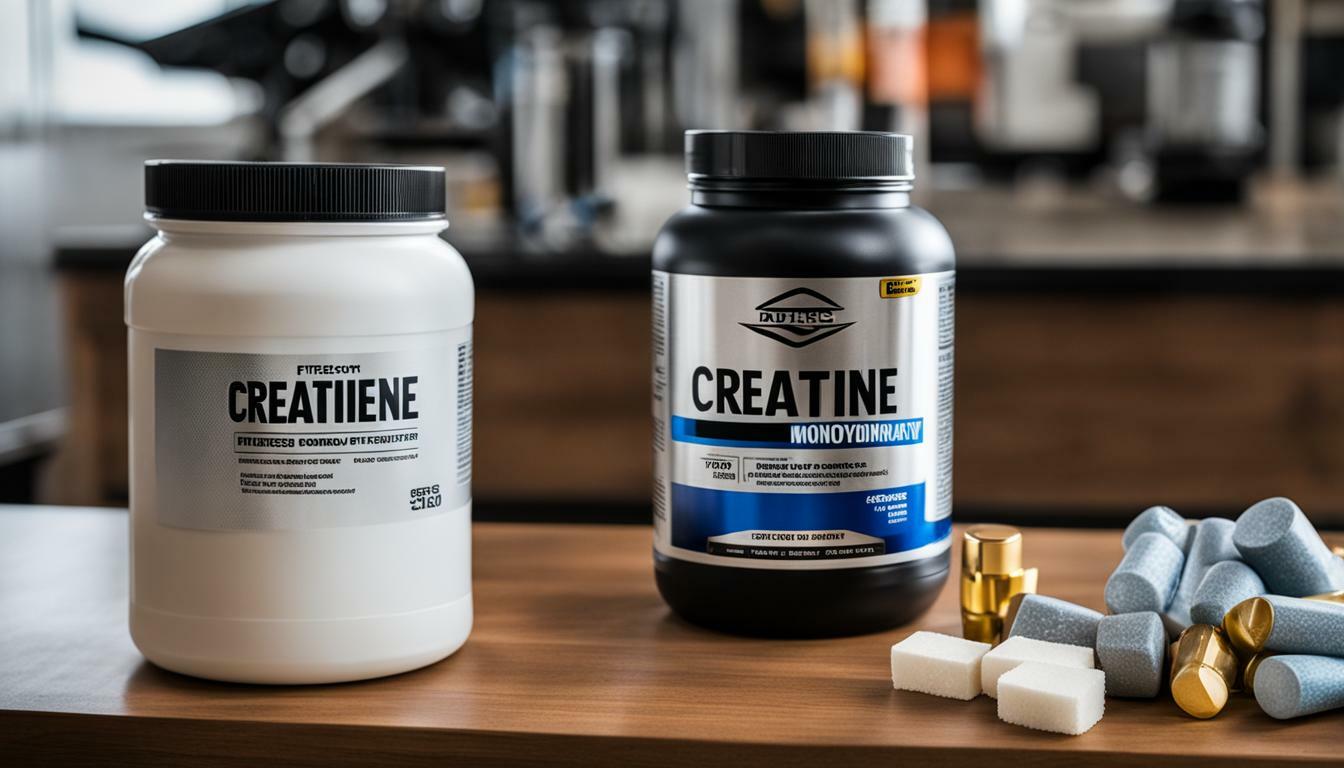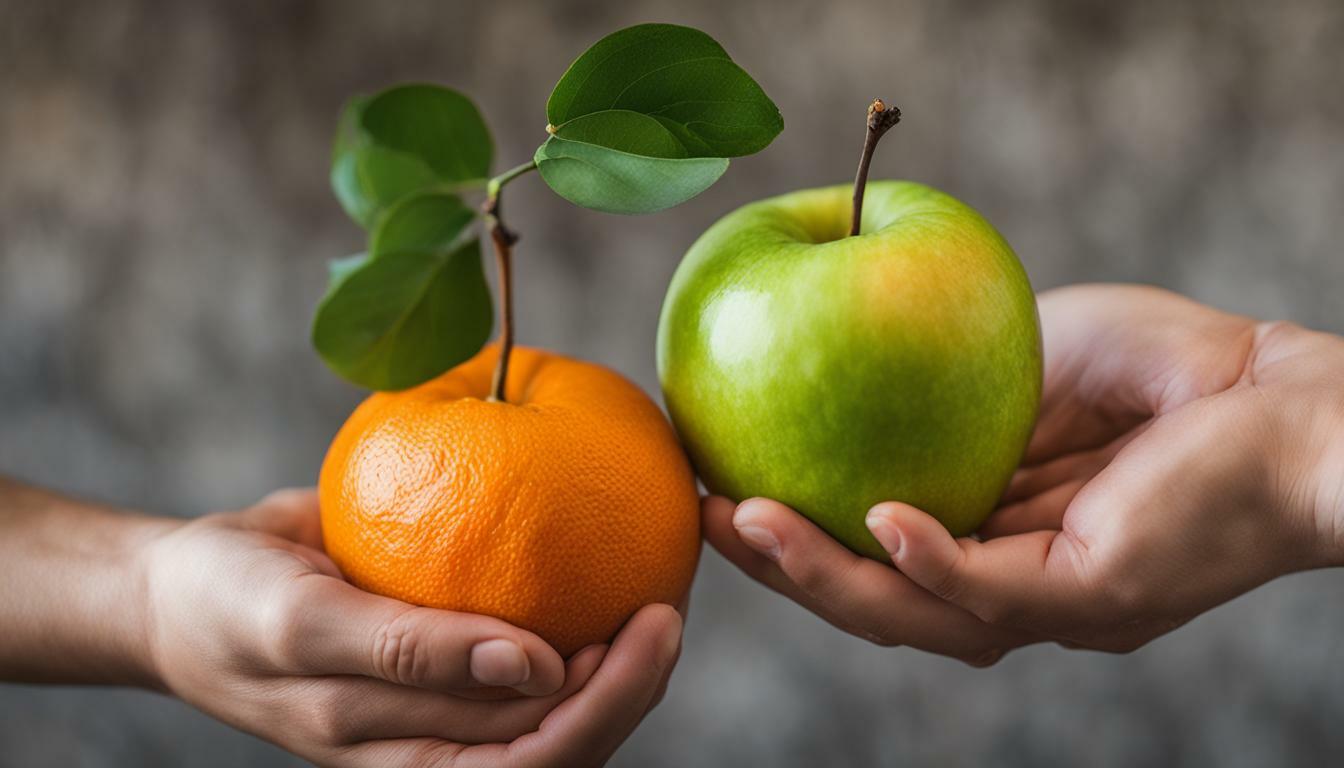Omega-3 fatty acids are essential for maintaining good health, and both chia seeds and flaxseeds are known for their high omega-3 content. These healthy fats play a crucial role in reducing inflammation, supporting brain function, and promoting heart health. But what sets chia seeds and flaxseeds apart when it comes to their omega-3 content? Let’s dive into the nutritional benefits of these two super seeds.
Key Takeaways:
- Flaxseeds contain more omega-3 fatty acids than chia seeds, with 6,000 mg of ALA per ounce compared to chia seeds’ 4,900 mg.
- Both chia seeds and flaxseeds are excellent sources of fiber and protein, with chia seeds having slightly higher fiber content.
- Flaxseeds are higher in lignans, which have antioxidant properties and may help reduce menopause symptoms, while chia seeds are higher in overall antioxidants.
- Chia seeds are a better source of calcium, while flaxseeds are slightly higher in protein.
- Both seeds have similar vitamin and mineral content, making them nutrient-dense additions to a healthy diet.
- When it comes to accessibility, both chia seeds and flaxseeds can be easily found in stores, but flaxseeds need to be ground before consumption, while chia seeds can be eaten whole.
- Both chia seeds and flaxseeds can be incorporated into a variety of dishes, providing a boost of nutrition and adding a pleasant texture.
Now that we have a brief introduction to the difference between chia and flax seeds’ omega-3 content, let’s explore the nutritional benefits, culinary uses, and overall advantages of incorporating these super seeds into your daily diet.
Omega-3 Content in Chia and Flax Seeds
When it comes to omega-3 fatty acid content, chia seeds and flaxseeds have distinct differences that are worth exploring. Flaxseeds contain more omega-3 fatty acids than chia seeds, with 6,000 mg of ALA per ounce compared to chia seeds’ 4,900 mg. However, both seeds are still great sources of omega-3s, providing valuable health benefits.
Chia seeds are known for their high fiber content, offering 11 grams per ounce compared to flaxseeds’ 8 grams. This makes chia seeds an excellent choice for supporting digestive health and promoting regularity. On the other hand, flaxseeds are higher in lignans, which have antioxidant properties and may help reduce menopause symptoms. Both seeds also contain a range of vitamins and minerals, contributing to overall nutrition.
In terms of accessibility, both chia seeds and flaxseeds can be found easily in stores. However, flaxseeds must be ground before consumption to unlock their full nutritional benefits. Chia seeds, on the other hand, can be eaten whole, making them more convenient for immediate use.
When it comes to usage, both seeds are versatile and can be added to a variety of dishes. From smoothies and yogurt to baked goods and salads, chia seeds and flaxseeds can add a nutritional boost to your meals. Their mild, nutty flavors make them a tasty addition to many recipes.
In summary, chia seeds and flaxseeds offer unique nutritional profiles, with variations in omega-3 content, fiber, antioxidants, and other essential nutrients. Incorporating these seeds into your diet can help support overall health and well-being. Whether you choose chia seeds or flaxseeds, both can be valuable additions to a balanced diet.
| Nutrient | Chia Seeds (per ounce) | Flaxseeds (per ounce) |
|---|---|---|
| Omega-3 Fatty Acids (ALA) | 4,900 mg | 6,000 mg |
| Fiber | 11 grams | 8 grams |
| Antioxidants | Higher overall | Higher in lignans |
| Calcium | 18% DV | 6% DV |
| Protein | 4.7 grams | 5.1 grams |
Other Nutritional Benefits of Chia and Flax Seeds
Chia seeds and flaxseeds offer more than just omega-3 fatty acids, as they are packed with other essential nutrients that contribute to overall health and well-being. These tiny seeds are a nutritional powerhouse, providing a wide range of vitamins, minerals, and antioxidants that support various bodily functions.
Both chia seeds and flaxseeds are rich in fiber, which aids in digestion and helps maintain healthy cholesterol levels. In fact, chia seeds contain more fiber than flaxseeds, with 11 grams per ounce compared to flaxseeds’ 8 grams. Fiber is also known to promote feelings of fullness, making it an excellent addition to a weight management plan.
When it comes to antioxidants, chia seeds and flaxseeds are at the top of the list. Antioxidants help protect our cells from damage caused by free radicals, reducing the risk of chronic diseases. While flaxseeds are higher in lignans, a type of antioxidant that may help alleviate menopause symptoms, chia seeds have a more comprehensive antioxidant profile.
| Benefits | Chia Seeds | Flaxseeds |
|---|---|---|
| Omega-3 Fatty Acids (per ounce) | 4,900 mg | 6,000 mg |
| Fiber (per ounce) | 11 g | 8 g |
| Lignans (per ounce) | Lower | Higher |
| Antioxidants | Higher | Lower |
| Calcium | Higher | Lower |
| Protein | Slightly lower | Slightly higher |
Summary:
- Chia seeds and flaxseeds offer more than just omega-3 fatty acids.
- Both seeds are high in fiber, but chia seeds have a slight advantage.
- Flaxseeds are higher in lignans, while chia seeds have a more robust antioxidant profile.
- Chia seeds are a better source of calcium, while flaxseeds have slightly more protein.
Adding these nutritious seeds to your diet is easy. You can sprinkle them on top of yogurt, blend them into smoothies, or use them in baking recipes. Whether you choose chia seeds or flaxseeds, incorporating these nutrient-packed seeds into your meals can contribute to a well-rounded and healthy diet.
Fiber Content Comparison
Adequate fiber intake is crucial for a healthy digestive system, and both chia seeds and flaxseeds are excellent sources of this essential nutrient. Chia seeds contain 11 grams of fiber per ounce, while flaxseeds have 8 grams of fiber. This means that chia seeds provide a slightly higher amount of fiber compared to flaxseeds.
Fiber plays a key role in promoting regular bowel movements and preventing constipation. It also helps to keep you feeling fuller for longer, which can aid in weight management. Additionally, fiber contributes to a healthy gut microbiome by serving as food for beneficial bacteria in the digestive system.
When it comes to incorporating fiber into your diet, both chia seeds and flaxseeds offer versatility. You can sprinkle them onto yogurt, add them to smoothies, or mix them into baked goods like muffins. They can also be used as a binder in recipes, such as when making vegan egg substitutes. However, it’s important to note that flaxseeds need to be ground before consumption to fully access their nutritional benefits.
| Nutrient | Chia Seeds (per ounce) | Flaxseeds (per ounce) |
|---|---|---|
| Fiber | 11 grams | 8 grams |
| Note: Nutritional values may vary slightly depending on the brand and source of the seeds. | ||
In summary, both chia seeds and flaxseeds can be included in a balanced diet to boost fiber intake. While chia seeds have a slightly higher fiber content, both seeds provide important health benefits and can be easily incorporated into various dishes and recipes.
Lignans and Antioxidants in Chia Seeds and Flaxseeds
Both chia seeds and flaxseeds contain lignans and antioxidants, which offer various health advantages, making them valuable additions to a balanced diet. Lignans are phytoestrogens that have been linked to a reduced risk of certain cancers, heart disease, and menopausal symptoms. Flaxseeds, in particular, are known to be a rich source of lignans. They contain up to three times more lignans than any other plant food.
On the other hand, chia seeds boast a higher overall antioxidant content compared to flaxseeds. Antioxidants are compounds that help protect the body against free radicals, which can cause oxidative stress and damage cells. The antioxidants found in chia seeds and flaxseeds contribute to their potential benefits for heart health, brain function, and inflammation reduction.
To further emphasize the nutritional value of chia seeds and flaxseeds, let’s take a look at the specific data:
| Nutrient | Chia Seeds | Flaxseeds |
|---|---|---|
| Omega-3 Fatty Acids (ALA) | 4,900 mg per ounce | 6,000 mg per ounce |
| Fiber | 11 g per ounce | 8 g per ounce |
| Lignans | Lower content compared to flaxseeds | Higher content compared to chia seeds |
| Antioxidants | Higher content compared to flaxseeds | Lower content compared to chia seeds |
As illustrated by the table, while flaxseeds have a higher lignan and omega-3 content, chia seeds excel in terms of fiber and overall antioxidant content. Both seeds offer unique nutritional profiles and can be easily incorporated into one’s diet. Whether you choose to include chia seeds or flaxseeds in your meals, both can contribute to a healthy lifestyle.
Calcium and Protein Comparison
Chia seeds and flaxseeds not only provide omega-3 fatty acids but are also rich in calcium and protein, vital for maintaining strong bones and muscle function. When it comes to calcium content, chia seeds take the lead. They contain approximately 177 milligrams of calcium per ounce, while flaxseeds provide about 43 milligrams per ounce. Calcium is crucial for bone health and plays a role in muscle contractions and nerve function.
Both chia seeds and flaxseeds are also excellent sources of plant-based protein. While flaxseeds have a slightly higher protein content, with around 5 grams per ounce, chia seeds still offer a significant amount at approximately 4 grams per ounce. Protein is essential for building and repairing tissues, supporting immune function, and producing enzymes and hormones.
Adding chia seeds or flaxseeds to your diet can help increase your intake of these important nutrients. Whether you sprinkle them on top of yogurt, blend them into smoothies, or use them as an egg substitute in baking, both seeds offer a convenient and versatile way to boost your calcium and protein intake. Remember to choose ground flaxseeds to ensure optimal absorption, as the whole seeds may pass through undigested.
| Calcium (mg) per ounce | Protein (g) per ounce | |
|---|---|---|
| Chia Seeds | 177 | 4 |
| Flaxseeds | 43 | 5 |
Accessibility and Usage
Chia seeds and flaxseeds are readily available in stores, but they differ in terms of ease of use, requiring different preparation methods. Chia seeds can be eaten whole, while flaxseeds need to be ground before consuming to ensure optimal nutrient absorption.
Chia seeds have a gel-like texture when soaked in liquid, making them a popular choice for creating healthy puddings, smoothies, and overnight oats. They can also be added to baked goods, such as muffins and bread, providing a subtle crunch and a boost of nutrition.
On the other hand, flaxseeds have a slightly nutty flavor and are commonly used in ground form. Grinding flaxseeds before using them can help release their nutrients and improve digestibility. Ground flaxseeds can be added to cereals, yogurt, and smoothies, or used as a substitute for eggs in vegan baking.
Chia Seeds Usage Ideas:
- Mix chia seeds with your favorite liquid (such as almond milk or coconut water) and let them sit for 15 minutes to create a tasty chia pudding.
- Add chia seeds to your morning smoothie for a nutritional boost.
- Sprinkle chia seeds on top of salads or roasted vegetables for added crunch.
Flaxseeds Usage Ideas:
- Grind flaxseeds and mix them into pancake or waffle batter for a fiber-packed breakfast.
- Incorporate ground flaxseeds into homemade granola bars or energy balls for a nutritious snack on the go.
- Blend ground flaxseeds into your favorite salad dressings or use them as a binding agent in veggie burgers.
| Chia Seeds | Flaxseeds | |
|---|---|---|
| Preparation | Eat whole or soaked | Ground before consuming |
| Texture | Gel-like when soaked | Slightly nutty |
| Usage | Puddings, smoothies, baking | Cereals, yogurt, smoothies, baking |
Similarities and Differences in Vitamin and Mineral Content
Chia seeds and flaxseeds offer a range of vitamins and minerals, although there are some variations in the specific nutrients they provide. Both seeds are rich in essential nutrients that can support overall health and well-being.
| Nutrient | Chia Seeds | Flaxseeds |
|---|---|---|
| Calcium | 179 mg per ounce | 54 mg per ounce |
| Iron | 2.1 mg per ounce | 1.6 mg per ounce |
| Magnesium | 95 mg per ounce | 138 mg per ounce |
| Zinc | 1 mg per ounce | 1.3 mg per ounce |
Chia seeds are a better source of calcium, with 179 mg per ounce compared to flaxseeds’ 54 mg. Calcium is essential for strong bones and teeth, as well as proper muscle and nerve function. However, flaxseeds are higher in magnesium, which plays a vital role in energy production and maintaining a healthy immune system.
Both seeds contain iron, with chia seeds providing 2.1 mg per ounce and flaxseeds providing 1.6 mg. Iron is essential for the production of red blood cells and oxygen transport throughout the body. Additionally, both seeds contain zinc, an important mineral for immune function and wound healing.
It’s important to note that while chia seeds and flaxseeds offer a range of vitamins and minerals, they should not be relied upon as the sole source of these nutrients in your diet. It’s always best to consume a varied and balanced diet to ensure you’re getting all the essential nutrients your body needs.
By incorporating these nutritious seeds into your diet, you can boost your intake of vitamins and minerals, providing support for overall health and well-being. Whether you choose chia seeds or flaxseeds, both can be a valuable addition to your daily meals and snacks.
Culinary Uses and Incorporation into the Diet
Chia seeds and flaxseeds are versatile ingredients that can be easily incorporated into a variety of dishes, from smoothies and salads to baked goods and cereals. Their nutritional benefits make them a popular choice for those looking to boost their intake of essential nutrients.
One of the simplest ways to enjoy chia seeds and flaxseeds is by adding them to a morning smoothie. Blend them with your favorite fruits, vegetables, and a liquid of your choice for a nutritious and filling start to your day. The seeds will add a subtle crunch and a boost of fiber and protein to your smoothie.
If you’re a fan of salads, sprinkle a tablespoon or two of chia seeds or flaxseeds over your greens for an added nutritional punch. They will add a nutty flavor and a pleasant texture to your salad and increase its fiber content, helping you stay fuller for longer.
Using Chia Seeds and Flaxseeds in Baking
Baking enthusiasts can also incorporate chia seeds and flaxseeds into their favorite recipes. Replace a portion of the flour in muffins, bread, or cookies with ground flaxseeds for a boost of fiber and omega-3 fatty acids. Chia seeds can be used as an egg substitute in vegan baking, as they form a gel-like consistency when mixed with water, similar to eggs.
Incorporating chia seeds and flaxseeds into your breakfast routine is easy. Sprinkle them over your yogurt, oatmeal, or cereal to add a nutritious crunch. The seeds will provide a dose of omega-3s, fiber, and protein to help fuel your day.
| Chia Seeds | Flaxseeds |
|---|---|
| High in fiber | Contain more omega-3 fatty acids |
| Rich in antioxidants | Higher in lignans |
| Good source of calcium | Higher in protein |
Whether you choose chia seeds or flaxseeds, incorporating these nutrient-rich ingredients into your diet is a delicious and easy way to improve your overall health.
Conclusion
In conclusion, both chia seeds and flaxseeds offer significant health benefits, including omega-3 fatty acids, but they also have their unique nutritional profiles that may suit different dietary needs.
When it comes to omega-3 content, flaxseeds contain more ALA, with 6,000 mg per ounce compared to chia seeds’ 4,900 mg. However, both seeds are still excellent sources of omega-3s, which are essential for heart health, brain function, and reducing inflammation.
Chia seeds take the lead in terms of fiber content, with 11 grams per ounce compared to flaxseeds’ 8 grams. Fiber is crucial for digestive health, maintaining healthy blood sugar levels, and promoting satiety.
Flaxseeds are higher in lignans, which are compounds with powerful antioxidant properties. These lignans may help reduce menopause symptoms and provide potential cancer-fighting benefits. On the other hand, chia seeds are higher in antioxidants overall, which play a vital role in protecting the body against oxidative stress and inflammation.
Chia seeds stand out as a better source of calcium, making them an excellent choice for those looking to boost their intake of this important mineral. Flaxseeds, on the other hand, are slightly higher in protein, which is essential for building and repairing tissues, as well as supporting a healthy immune system.
Both chia seeds and flaxseeds offer similar vitamin and mineral content, providing essential nutrients such as magnesium, phosphorus, and potassium. These seeds can be easily incorporated into the diet and added to a variety of dishes, such as smoothies, yogurt, oatmeal, or baked goods.
In summary, chia seeds and flaxseeds are both nutritious powerhouses and can be great additions to a healthy diet. It is beneficial to include a variety of seeds in your meals to reap the diverse range of nutritional benefits they offer. So, go ahead and enjoy the many health benefits of these tiny yet mighty seeds!
FAQ
Q: What are the main differences between chia seeds and flaxseeds in terms of omega-3 content?
A: Flaxseeds contain more omega-3 fatty acids than chia seeds, with 6,000 mg of ALA per ounce compared to chia seeds’ 4,900 mg.
Q: Are both chia seeds and flaxseeds good sources of omega-3s?
A: Yes, both seeds are still great sources of omega-3s.
Q: Which seed has more fiber, chia seeds or flaxseeds?
A: Chia seeds have more fiber, with 11 g per ounce compared to flaxseeds’ 8 g.
Q: What is the difference in lignan content between chia seeds and flaxseeds?
A: Flaxseeds are higher in lignans, which have antioxidant properties and may help reduce menopause symptoms.
Q: Which seed contains more antioxidants, chia seeds or flaxseeds?
A: Chia seeds are higher in antioxidants overall.
Q: Which seed is a better source of calcium?
A: Chia seeds are a better source of calcium.
Q: Which seed has slightly higher protein content, chia seeds or flaxseeds?
A: Flaxseeds are slightly higher in protein compared to chia seeds.
Q: Are there any differences in the vitamin and mineral content of chia seeds and flaxseeds?
A: Both seeds have similar vitamin and mineral content.
Q: Do chia seeds and flaxseeds require any specific preparation before consumption?
A: Flaxseeds must be ground before consuming, while chia seeds can be eaten whole.
Q: How can chia seeds and flaxseeds be incorporated into the diet?
A: Both seeds can be added to a variety of dishes.
 Skip to main content
Skip to main content


